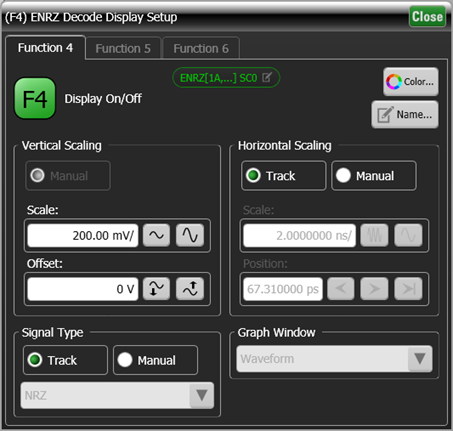ENRZ Operator

 The ENRZ Decode (Ensemble NRZ) operator decodes an ENRZ coded signal. It is one of two chord operators. The operator takes the four encoded input signals (representing three bits of information) and outputs three decoded NRZ waveforms with each output representing one of the three output bits. With three bits/symbol, the shortest pattern length to show all possible bit combinations is 8 symbols long (23 symbols).
The ENRZ Decode (Ensemble NRZ) operator decodes an ENRZ coded signal. It is one of two chord operators. The operator takes the four encoded input signals (representing three bits of information) and outputs three decoded NRZ waveforms with each output representing one of the three output bits. With three bits/symbol, the shortest pattern length to show all possible bit combinations is 8 symbols long (23 symbols).
To ensure proper decoding, the input waveforms must be aligned.
After placing the operator in the construction area, drag the four input channels or memory waveform inputs from the left-side panel onto the operator's left-side inputs. Drag right-side function colors to the operator's right-side outputs. If your input waveforms are in files, first load each waveform file into either a waveform memory (preferred method) or a simulated module's channel. If you import them into a simulated module, you must specify the waveform's amplitude in the simulated module's Setup dialog.
The following picture shows all of the ENRZ waveforms displayed in FlexDCA's Oscilloscope mode. All possible bit combinations are shown. The amplitude of the output signals are all equal.

| Connection | Description | Idealized Eye Diagram on Each Input/Output |
|---|---|---|
| Inputs |
Four ENRZ encoded channels (or memories) which together represent one ENRZ coded signal:
|
Multilevel: 
|
| Outputs | Three decoded waveforms (Sub-Channels) each in NRZ format where each waveform represents a bit:
|
NRZ: 
|
Configuring the Operator
 After connecting the operator's inputs to channels or memories and the operator's outputs to displayed waveforms, click on the operator to open the ENRZ Decode Display Setup dialog. Use the dialog's tabs to turn the display of each output waveform on or off and to configure its vertical scaling, horizontal scaling, signal type, and graph window. In the dialog and on the displayed waveform, notice that the output waveform's name includes the term "SC" which stands for Sub Channel. The name also includes the function output port's number.
After connecting the operator's inputs to channels or memories and the operator's outputs to displayed waveforms, click on the operator to open the ENRZ Decode Display Setup dialog. Use the dialog's tabs to turn the display of each output waveform on or off and to configure its vertical scaling, horizontal scaling, signal type, and graph window. In the dialog and on the displayed waveform, notice that the output waveform's name includes the term "SC" which stands for Sub Channel. The name also includes the function output port's number.
